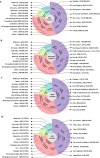A matched case-control analysis of autonomous vs human-driven vehicle accidents
- PMID: 38890354
- PMCID: PMC11189485
- DOI: 10.1038/s41467-024-48526-4
A matched case-control analysis of autonomous vs human-driven vehicle accidents
Abstract
Despite the recent advancements that Autonomous Vehicles have shown in their potential to improve safety and operation, considering differences between Autonomous Vehicles and Human-Driven Vehicles in accidents remain unidentified due to the scarcity of real-world Autonomous Vehicles accident data. We investigated the difference in accident occurrence between Autonomous Vehicles' levels and Human-Driven Vehicles by utilizing 2100 Advanced Driving Systems and Advanced Driver Assistance Systems and 35,113 Human-Driven Vehicles accident data. A matched case-control design was conducted to investigate the differential characteristics involving Autonomous' versus Human-Driven Vehicles' accidents. The analysis suggests that accidents of vehicles equipped with Advanced Driving Systems generally have a lower chance of occurring than Human-Driven Vehicles in most of the similar accident scenarios. However, accidents involving Advanced Driving Systems occur more frequently than Human-Driven Vehicle accidents under dawn/dusk or turning conditions, which is 5.25 and 1.98 times higher, respectively. Our research reveals the accident risk disparities between Autonomous Vehicles and Human-Driven Vehicles, informing future development in Autonomous technology and safety enhancements.
© 2024. The Author(s).
Conflict of interest statement
The authors declare no competing interests.
Figures







Similar articles
-
A case study of unavoidable accidents of autonomous vehicles.Traffic Inj Prev. 2024;25(1):8-13. doi: 10.1080/15389588.2023.2255333. Epub 2023 Nov 30. Traffic Inj Prev. 2024. PMID: 37722829
-
Exploratory analysis of injury severity under different levels of driving automation (SAE Levels 2 and 4) using multi-source data.Accid Anal Prev. 2024 Oct;206:107692. doi: 10.1016/j.aap.2024.107692. Epub 2024 Jul 20. Accid Anal Prev. 2024. PMID: 39033584
-
How should human-driven and autonomous vehicles behave at a zebra crossing? Determining acceptable stopping distances and setting-off times.Accid Anal Prev. 2024 Dec;208:107783. doi: 10.1016/j.aap.2024.107783. Epub 2024 Sep 16. Accid Anal Prev. 2024. PMID: 39288452
-
Research Scenarios of Autonomous Vehicles, the Sensors and Measurement Systems Used in Experiments.Sensors (Basel). 2022 Aug 31;22(17):6586. doi: 10.3390/s22176586. Sensors (Basel). 2022. PMID: 36081043 Free PMC article. Review.
-
Comparability of driving automation crash databases.J Safety Res. 2025 Feb;92:473-481. doi: 10.1016/j.jsr.2025.01.004. Epub 2025 Feb 6. J Safety Res. 2025. PMID: 39986865 Review.
Cited by
-
Analysis of safety risks in mixed driving of manual and automawtic vehicles: multiple perspectives.PLoS One. 2025 May 15;20(5):e0320834. doi: 10.1371/journal.pone.0320834. eCollection 2025. PLoS One. 2025. PMID: 40373028 Free PMC article.
-
Knowledge-guided self-learning control strategy for mixed vehicle platoons with delays.Nat Commun. 2025 Aug 19;16(1):7705. doi: 10.1038/s41467-025-62597-x. Nat Commun. 2025. PMID: 40830216 Free PMC article.
References
-
- Lee D, Hess DJ. Regulations for on-road testing of connected and automated vehicles: Assessing the potential for global safety harmonization. Transp. Res. Part A. 2020;136:85–98.
-
- Zhang, L. Cruise’s Safety Record Over 1 Million Driverless Miles, https://getcruise.com/news/blog/2023/cruises-safety-record-over-one-mill... (2023).
-
- DMV, C. Autonomous vehicle collision reports, https://www.dmv.ca.gov/portal/vehicle-industry-services/autonomous-vehic... (2023).
MeSH terms
LinkOut - more resources
Full Text Sources

